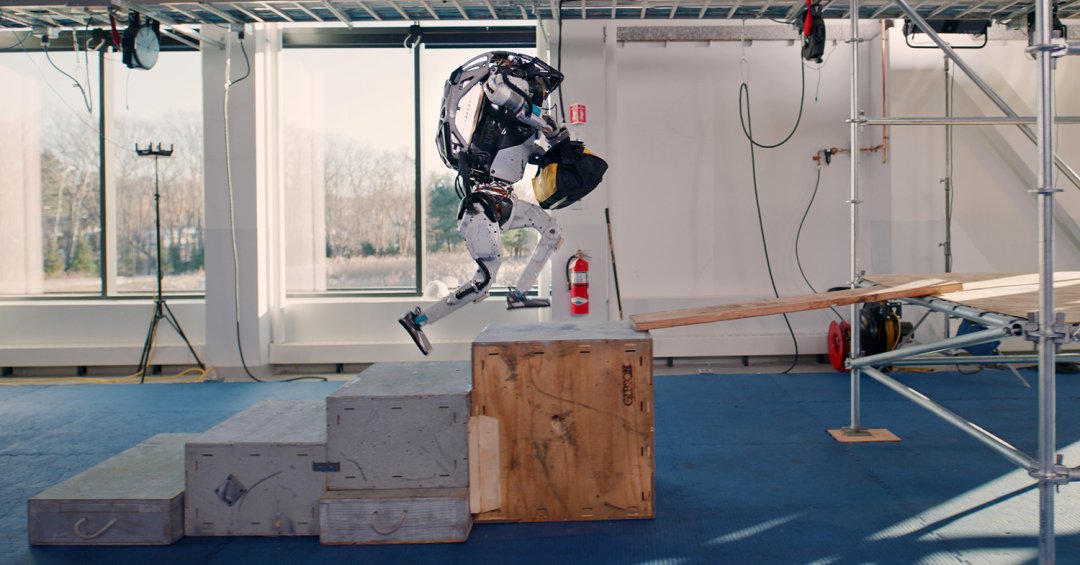|
Listen to this article  |
Boston Dynamics never disappoints when it releases a video showing new capabilities for its robots. And it just released a video, “Atlas Gets a Grip,” in which the humanoid performs a slew of new moves at a simulated construction site.
A “construction worker” atop a scaffold conveniently forgot some tools down on the ground. Instead of hopping down to get the tools himself, Atlas brings the tools to him. And this is where the magic happens.
Atlas, using a claw gripper, picks up and manipulates a wooden plank to create a bridge for itself onto the scaffold. It then picks up a toolbag, runs onto the scaffold, spins around and throws the toolbag up to the construction worker. Atlas then pushes a wooden box off the scaffold and flips and twists its way to the ground.
You can watch the video atop this page. Boston Dynamics said the new capabilities represent a natural progression of the humanoid robot’s skillset, particularly in areas of perception, manipulation and autonomy. Atlas’ ability to pick up and move objects of different sizes, materials, and weights while staying balanced is enabled by improved locomotion and sensing capabilities.
For this video, Boston Dynamics installed utility “claw” grippers with one fixed finger and one moving finger. Boston Dynamics said this gripper debuted during its Super Bowl commercial when Atlas lifted a keg over its head. These simple grippers are designed for heavy lifting tasks.
According to Boston Dynamics, some of the other new capabilities include:
- Improved control systems in order to jump 180-degree jump while holding the wooden plank.
- Performing a spinning jump while throwing the tool bag. To accomplish this task, Boston Dynamics extended the model predictive controller (MPC) to consider the coupled motion of both the robot and object together.
- Pushing the wooden box from the platform, which meant Atlas needed to generate enough power to cause the box to fall without sending itself off of the platform.
- Atlas’ concluding move, an inverted 540-degree, multi-axis flip, adds asymmetry to the robot’s movement making it a much more difficult skill than previously performed parkour.
“We’re layering on new capabilities,” said Ben Stephens, Atlas controls lead, Boston Dynamics. “Parkour and dancing were interesting examples of pretty extreme locomotion, and now we’re trying to build upon that research to also do meaningful manipulation. It’s important to us that the robot can perform these tasks with a certain amount of human speed. People are very good at these tasks, so that has required some pretty big upgrades to the control software.”
Boston Dynamics released a must-watch video (below) that takes you behind the scenes of how this new routine was developed.
In a blog, Boston Dynamics explained some of the more complex sequences in the new routine. Stephens said Atlas manipulating the large wooden plank was especially challenging. Instead of turning around cautiously, Atlas performed a 180-degree jump while holding the plank. Stephens said this meant Atlas’ control system needed to account for the plank’s momentum to avoid toppling over.
He also said pushing the wooden box from the platform is a deceptively complex task. Atlas needed to generate enough force to cause the box to fall, leaning its weight into the shove without sending its own body off the platform.
Stephens also said the flip at the end of the routine is much more difficult than previous acrobatics. The twist adds asymmetry that doesn’t exist in a regular backflip. Not only is the math more complicated, but in trial runs, Atlas kept getting tangled in its own limbs as it tucked its arms and legs.
“We’re using all of the strength available in almost every single joint on the robot,” Deits says. “That trick is right at the limit of what the robot can do.”
Stephens said humanoids that can routinely tackle dirty and dangerous jobs in the real world are a “long way off.” So it appears Atlas will remain a research platform for the foreseeable future.
“Manipulation is a broad category, and we still have a lot of work to do,” he said. “But this gives a sneak peek at where the field is going. This is the future of robotics.”

Credit: Source link


Comments are closed.